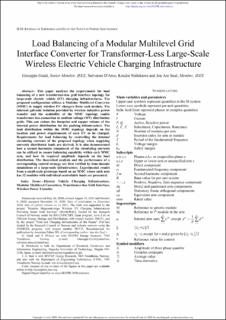| dc.contributor.author | Guidi, Giuseppe | |
| dc.contributor.author | D'Arco, Salvatore | |
| dc.contributor.author | Nishikawa, Koudai | |
| dc.contributor.author | Suul, Jon Are Wold | |
| dc.date.accessioned | 2021-07-19T11:21:49Z | |
| dc.date.available | 2021-07-19T11:21:49Z | |
| dc.date.created | 2020-12-29T17:15:42Z | |
| dc.date.issued | 2020 | |
| dc.identifier.issn | 2168-6777 | |
| dc.identifier.uri | https://hdl.handle.net/11250/2764763 | |
| dc.description.abstract | This paper analyses the requirements for load balancing of a new transformer-less grid interface topology for large-scale electric vehicle (EV) charging infrastructures. The proposed configuration utilizes a Modular Multilevel Converter (MMC) to supply wireless EV chargers from each module. The inherent galvanic isolation provided by wireless inductive power transfer and the scalability of the MMC topology enable transformer-less connection to medium voltage (MV) distribution grids. This can reduce the footprint and copper volume of the internal power distribution for the parking infrastructure. The load distribution within the MMC topology depends on the location and power requirements of each EV to be charged. Requirements for load balancing by controlling the internal circulating currents of the proposed topology when supplying unevenly distributed loads are derived. It is also demonstrated how a second harmonic component of the circulating currents can be utilized to ensure balancing capability within each MMC arm, and how its required amplitude depends on the load distribution. The theoretical analysis and the performance of a corresponding control strategy are first verified by time-domain simulations of a large-scale infrastructure. Experimental results from a small-scale prototype based on an MMC where each arm has 12 modules with individual controllable loads are presented. | en_US |
| dc.language.iso | eng | en_US |
| dc.publisher | IEEE | en_US |
| dc.title | Load Balancing of a Modular Multilevel Grid Interface Converter for Transformer-Less Large-Scale Wireless Electric Vehicle Charging Infrastructure | en_US |
| dc.type | Peer reviewed | en_US |
| dc.type | Journal article | en_US |
| dc.description.version | acceptedVersion | en_US |
| dc.source.journal | IEEE Journal of Emerging and Selected Topics in Power Electronics | en_US |
| dc.identifier.doi | 10.1109/JESTPE.2020.3043211 | |
| dc.identifier.cristin | 1863940 | |
| dc.relation.project | Norges forskningsråd: 284231 | en_US |
| dc.relation.project | Norges forskningsråd: 295133 | en_US |
| cristin.ispublished | true | |
| cristin.fulltext | postprint | |
| cristin.qualitycode | 1 | |
